Architecture for the Living (2017)
Vito Acconci
Mike Kelly
Aangeraden door Rolf- toen bij de Toermalijn op 29/10/20
Hij heeft maquettes gemaakt, en iets gedaan met het koppelen van ruimtes, om zo een nieuwe denkbeeldige ruimte te creëren.
Copypasta- "Mike Kelley’s Educational Complex- It consists of eight tabletop architectural models, each representing every school Mike Kelley attended, as well as the house that he grew up in.
Educational Complex explores how we remember spaces—and how much of them we forget.
The implication is that anything that can’t be remembered is somehow the result of trauma.
No one’s going to think that when they look at it. It looks completely orderly. It doesn’t look dysfunctional at all. But seen through the theory of repressed memory syndrome, that’s what it means."
Vond ineens een boek van hem in m'n boekenkast entitled 'the city inside us'.
THE CITY INSIDE US
EDUCATIONAL COMPLEX
Copypasta- "In his Viennese exhibition The City Inside Us (MAK, 1993), Vito Acconci carried out a vehement act of spatial intervention, a no-holds-barred externalization, a consciously executed exposure of his own self: a dramatic “look inward,” a battle against repressed subjectivity, and at the same time — in a surprising light — the impression of an anticipated reconciliation."
Dit is een interessant werk omdat het rare, 'dode' hoeken creëert, door het gebouw op/in zichzelf te laten imploderen. In werkelijkheid is dit ongeveer wat er gebeurd in veel grote steden waar snelle urbanisatie plaatsvond in plekken net buiten de stad.
In het boek 'The city inside us' staat ook een hele interessante essay door Anthony Vidler- 'Home Alone', waar in hij ook de opmars van architectuur vergelijkt met een soort pandemie, en het wegdrukken van mensen die niet in de economisch dominante paradigma vallen.
"In the new sites of domestic biological warfare, design strategies, envision the triumph of the homeless of people with AIDS, of people of color, and those marginalised by gender or sexual preference, not through armed combat, but through spatial revolution." (Vidler, or William R. Kenan, in 'The City Inside Us' (1993), Peter Noever, MAK)
Lars Von Trier
THE HOUSE THAT JACK BUILT
Aangeraden door Muz- Toermalijn 29/10/20
Vrouwonvriendelijke (goed scrabble woord) film waarin architecturale modellen een interessante rol spelen.
Copypasta- "Jack is an engineer but wanted to be an architect. He designs his dream house - several versions of it - and has many models to show for it."
Ik weet nog niet precies wat nou de rol is van de modellen in de film- maar het lijkt er op dat de onuitgekomen droom van Jack om architect te worden een onderliggende drive is
Copypasta- "Jack’s confessional narration also has the air of a self-justification, which he delivers in the form of his philosophical discourses on aesthetics. In his youth, Jack aspired to become an architect; he complied with his mother’s insistence that he become an engineer instead, and, now, having inherited a large (unspecified) sum of money, he attempts to satisfy his long-frustrated ambition. In a farcically literal rendering of the movie’s title, he buys a remote piece of lakeside property, designs a small house that he builds as a paper model in his pristine studio, and sets out to build it. “The House That Jack Built” depicts Jack’s architectural frustrations and exertions as his longtime and central motive for his career of murder."
Bruce Nauman
Three Dead End Adjacent Tunnels, Not Connected
Copy Pasta: "Nauman began working with quasi-architectural spaces in the late 1960s. In his corridor installations, such as Corridor with Mirror and White Lights 1971 (Tate T01753), he constructed spaces which disorientate the viewer through the use of mirrors, sound or video cameras. The interior spaces created in these works aimed to disrupt and examine individual behaviour. The artist gradually expanded them to confront larger social and political issues, planning to create 'uncomfortable spaces and shapes even on a very large scale for lots and lots of people' (Nauman quoted in Bruce Nauman 1994, p.33).
In 1972 Nauman began to make drawings for a series of proposed tunnel pieces. He began building the sculptural models in 1977, using scrap materials and a rough, unfinished method of construction to create works which appear to be maquettes rather than architectural structures. They vary in scale from small cardboard collage-like structures to huge fibreglass and plaster sculptures. Many are suspended by wire from the ceiling; others sit on supports on the floor. Having studied maths at university, Nauman retained a fascination with geometric equations, particularly the relationship between squares, circles and triangles. 'I find triangles really uncomfortable, disconcerting kinds of spaces. There is no comfortable space to stay inside them or outside them. It's not like a circle or square that gives you security.'(Nauman quoted in Simon, p.147.)
Providing potential spaces for containment and connection between bodies, the tunnels are evocative of confinement and claustrophobia. In Three Dead End Adjacent Tunnels, Not Connected the need for communication within and between these proposed internal spaces is displayed as thwarted and impossible. As the title indicates, the three triangular-shaped spaces, which themselves form a triangle, are in contact with each other but not in communication. A metaphor for human relations within a group, they present a bleak comment on self-containment, confinement and isolation. This sculpture is the finished version of a plaster and wood construction of 1979; it is a unique piece. In this year Nauman moved to Pacos, New Mexico, where he built a new studio."
Tip van Muz (geloof ik..). Maquettes as art.
"Providing potential spaces for containment and connection between bodies, the tunnels are evocative of confinement and claustrophobia. "
Aernout Mik
Copy Pasta "In het werk van Aernout Mik (Groningen, 1962) gaan videobeelden en architectuur een nauwe relatie met elkaar aan. Mik toont zijn videowerk in ruimtelijke, architecturale structuren die hij zelf ontwerpt. Het zijn omgevingen waarin het werk een fysieke ervaring wordt; de videowerken zijn als het ware sculpturen waar de toeschouwer zich tot moet verhouden."
Tip van Rolf. Film, architectuur en de schaal van de architectuur spelen een belangrijke rol in zijn werk.
Besler & Sons
"Going Around the Corner Piece 1970, by American artist Bruce Nauman, seems to sum up this elusive encounter between art and life, object and viewer. Taking the cube and turning it into an architectural structure, Nauman creates a work that is both physically and intellectually disorienting. Video cameras and monitors on each corner record viewers as they negotiate the structure. Their contribution to the work is essential: they become the performers, the subject being filmed. However, Nauman denies them a view of their own participation: the camera is aimed at their back, so they can never quite catch up; they are always just out of sight. Like rats in an experimental maze, viewers become part of an interactive system that is an absurd enactment of frustration and failure."
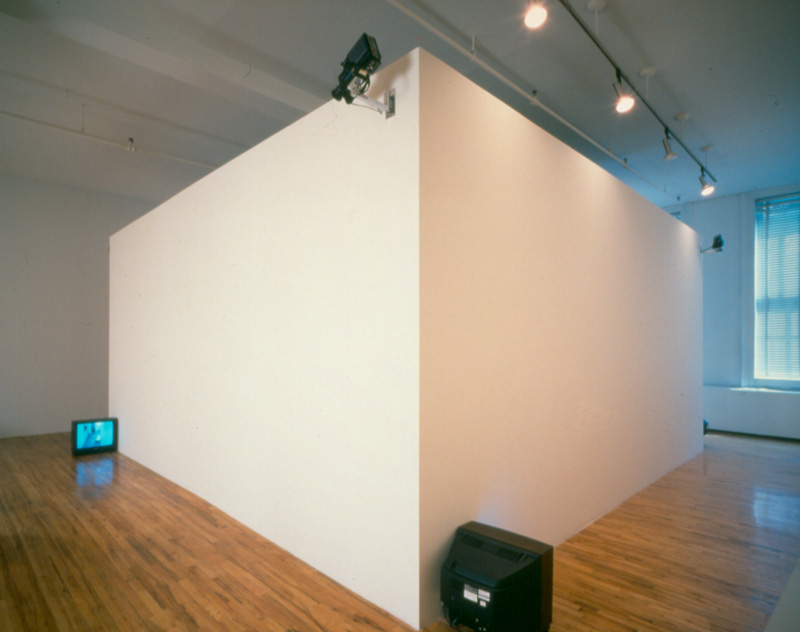
Copy Pasta: "Finally, this astonishing retrospective, as the very title may suggest, is actually a renewed interpretation and sort of a mapping of the escapist strategy which is recurrent during his entire career. The audience has a chance to explore how this artist expressed literal and figurative incidents of removal, deflection, and concealment. Withdrawal and vanishing are the themes which seem to haunt Nauman which makes his works in a sync with contemporaneity colored with social and political absurdity."
Interessant werk om te zien, maar ik kan nergens precies vinden wat het idee achter dit werk is.
"the architectural models [...] posit real or imaginary sites as models for ethical inquiry and mechanisms of control."
Copy Pasta: "The sense of confinement also figures in Model for Trench and Four Buried Passages (1977), a giant labyrinth-like structure, which the visitor can’t enter, but can imagine being lost in for ever. Like much of Nauman’s work, it is an entrapment that affects our imagination."
Going around the Corner Piece 1970
Model for Trench and Four Buried Passages (1977)
This project presented mockups of walls, three rooms, to suggest that material thickness is an architectural problem where multiple forms of knowledge meet. The project was installed at The MAK Center for Art and Architecture, Los Angeles Mackey Apartments Garage Top 1137 South Cochran Avenue. This project was supported by the University of California Los Angeles Department of Architecture and Urban Design as part of the 2013-2014 UCLA A.UD Teaching Fellowship.
THE ENTIRE SITUATION (2013-2014)
Urban Planning
Constant Nieuwenhuys
NEW BABYLON (1956-74)
Copypasta- "Tussen 1956 en 1974 werkte beeldend kunstenaar Constant Nieuwenhuys aan New Babylon, een model voor een nieuwe samenlevingsvorm die gestalte kreeg in een enorme stroom aan schilderijen, tekeningen, lichtvoorstellingen, teksten en maquettes. De welvaartsmachine die na de oorlog op stoom kwam, met zijn versnellende industrialisering en automatisering, deed Constant vermoedde dat er op termijn geen menselijke arbeid meer nodig was. De homo faber, de werkende mens, zou plaatsmaken voor de homo ludens, de spelende mens. Niet meer plaats- en tijdsgebonden aan werk, kon hij zijn overmaat aan vrije tijd doorbrengen als nomade in zijn leefomgeving. Voor deze homo ludens ontwierp Constant ver boven de bestaande wereld van stad en landschap getild megastructuren, die met verplaatsbare wanden, trappen en bruggen zijn permanente en continu veranderende speelruimte zouden vormen. Een radicaal andere ‘stad’ bestaande uit sectoren die op de psycho-emotionele gesteldheid van haar dwalers aansluit – de droevige sector, de blauwe sector. De stad zou geen eigendom meer kennen, iedereen was vrij om de ruimte te gebruiken en te veranderen. New Babylon was een delirium van openbare ruimte."
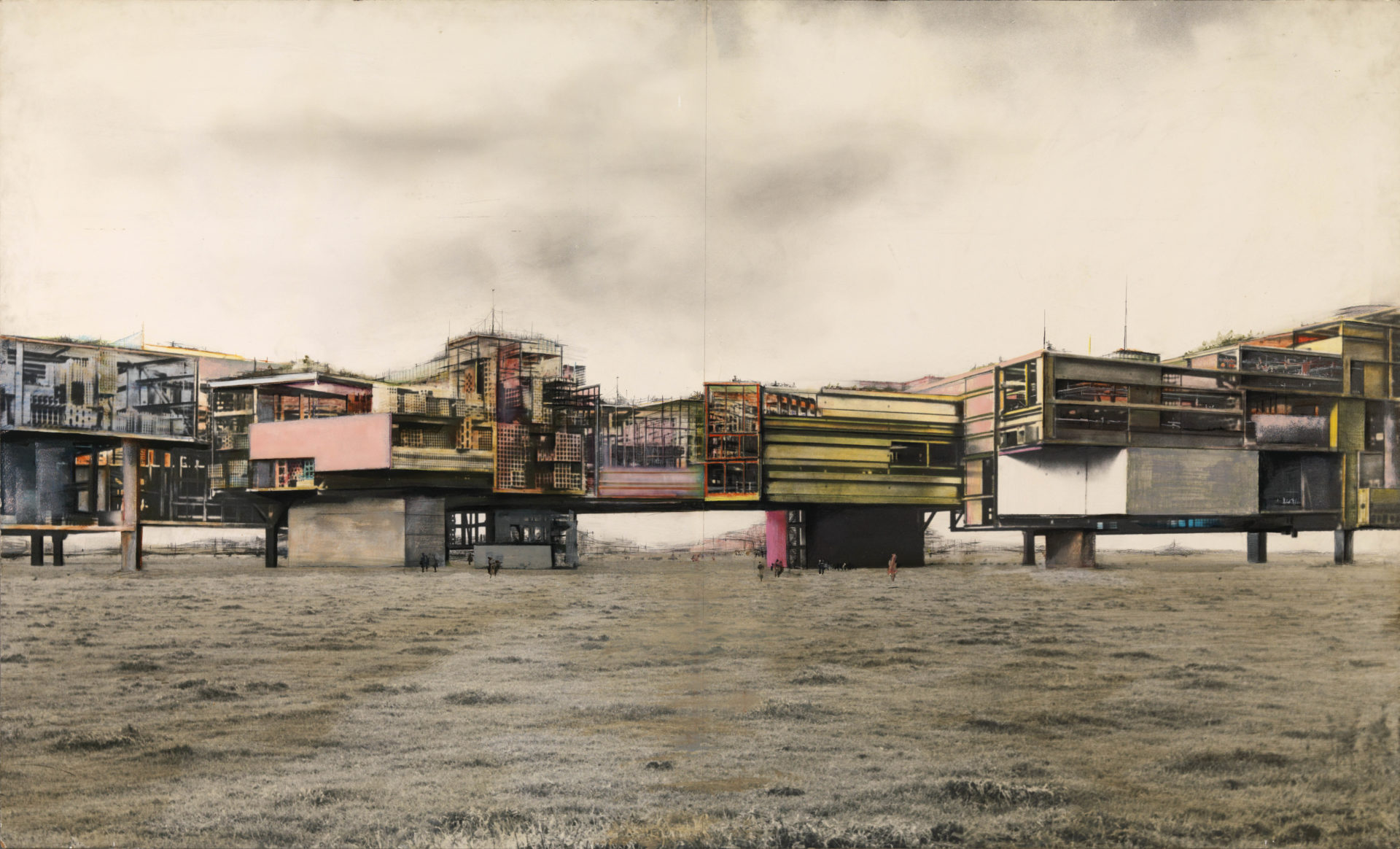
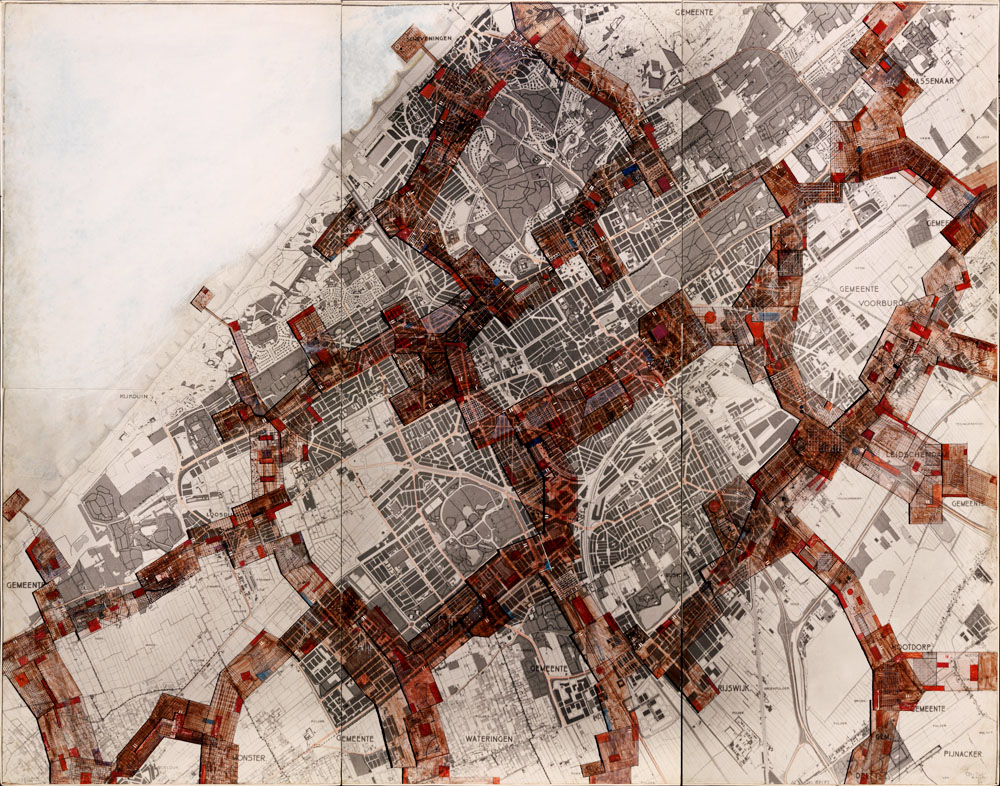
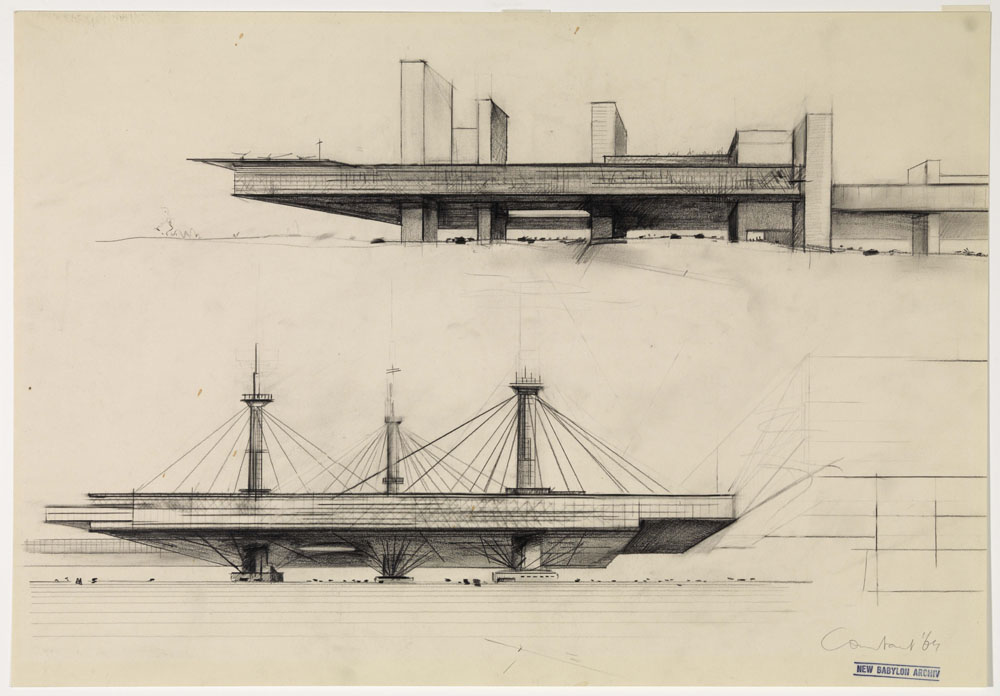
Urban planning can be elitist, but art empowers people to reimagine their city’s future – artist’s view
Copy Pasta "Administrators of urban space would like to have the public believe that the urban environment has a predetermined function: a bench is for sitting, not sleeping, on; a train station is for people on the move, not for people seeking shelter; a park is for families with children, not for groups of young people – and so on.
This “given order” of things risks making residents feel alienated from urban spaces. When the city’s functions are already decided, there is little room for residents to adapt its spaces according to their own needs. Urban space becomes a sort of jigsaw puzzle: the pieces can be moved around, but they only fit in one way. There is only one predetermined and rational way to assemble the pieces.
But in participatory art, urban space can be reimagined as a mosaic: the pieces fit together in many different ways, and the final outline is not predetermined. Different pieces can relate to each other to produce different forms and make new connections, depending on how you arrange them. This way of thinking about the city gives local people the freedom to articulate what matters to them, and express their own vision for the city’s future.
And when participants engage in collaborative model-making, using found objects to express their dreams and desires for their city, they are given space to imagine alternatives, without being mired in everyday realities and demands for concrete solutions on “how to get there”.
In the present political climate, democracy is seemingly becoming less sensitive to the demands of citizens calling for more just distribution of resources, a cleaner environment or the defence of common goods. Participatory art has the potential to give city dwellers a sense of agency, empowerment and entitlement, by promising that everyone is capable of imagining how things could be different. And that’s the first step toward forging a better future."
By Cecilie Sachs Olsen
Materiality as performance
Blurring the boundaries between the real and the imagined (2016)
By Cecilie Sachs Olsen
Copy Pasta "Materiality as performance is a dialectical approach to urban space. It seeks to interrogate the interplay between the imagined and the material, and in this way provide a powerful lens through which residents can view their city and collectively envision, negotiate and articulate alternatives to present conditions. Urban inhabitants tend to be placed in passive roles as consumers rather than active citizens, framing the politics of the city as concerned with developing capitalist accumulation rather than human potential. Imagination is socially placed within the domains of non-authority such as the childish, placing the loci of authority in the marketplace, the state or the university – places that deal with the ‘real’ world. Seeing materiality as performance is an attempt to subvert this distinction between the ‘real’ and the imaginary by refusing to accept what is presented to us as given."
Montopia (2014)
By zURBS
Copy Pasta "Did you ever walk the streets of Monthey dreaming that something could be different? This week we are building a city model out of your different ideas, visions and dreams for Monthey. It will not be a model of Monthey, but a model of MONTOPIA. Montopia is the Monthey of our imaginations and desires.
In Monthey, zURBS involved a broad range of residents (children, teenagers, architects, politicians, unemployed, parent-groups, cultural workers etc.) to create a model of Montopia –the Monthey of their dreams. On a 2 x 2 m plywood plate with the map of Monthey printed on it, the residents built Montopia out of objects they had found in the city. zURBS would go to all the places where the models had been placed on the map, take a picture of the place and then Photoshop the model into the “real” place where the residents had placed it. This way, a plausible reality was created out of people’s dreams and imaginations. The model together with these photoshopped montages as well as descriptions and explanations for each building were then exhibited at the festival centre."
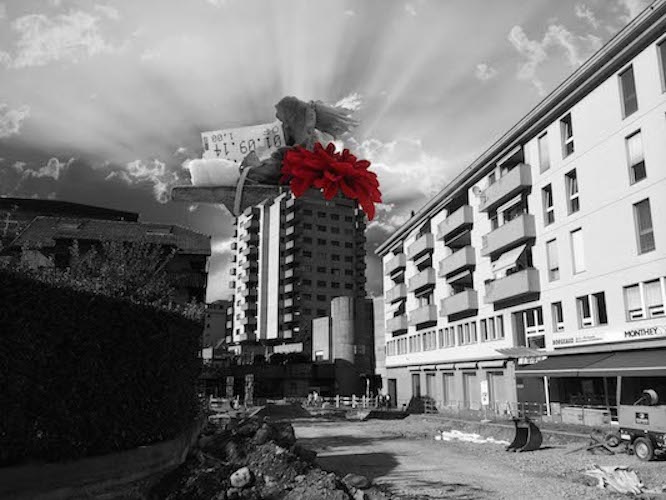
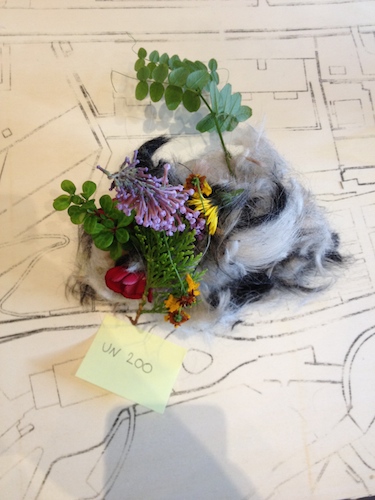
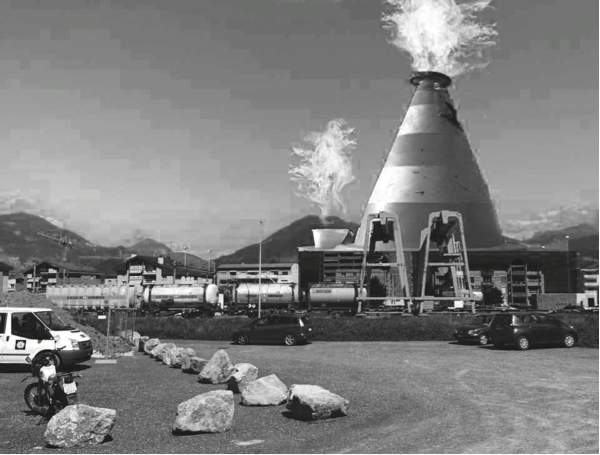
" urban space can be reimagined as a mosaic: the pieces fit together in many different ways, and the final outline is not predetermined. Different pieces can relate to each other to produce different forms and make new connections, depending on how you arrange them. This way of thinking about the city gives local people the freedom to articulate what matters to them, and express their own vision for the city’s future."
" People don’t meet in the large main square, the marketplace, but on the phone, which is the medium used to set appointments. Proximity isn’t necessary anymore as modern technology now allows for the dilution of cities."
By Yona Friedman
Copy Pasta "A historical figure of prospective architecture, Yona Friedman describes the importance of the model of communication embodied by the living organism, a source of inspiration for an architecture for living beings rather than a living entity in itself. He looks back at technological developments in the field of communications, that allow us to do away with the classical urban imperative of proximity, and also looks back at the liberation of the individual with respect to networks, that still represented an obstacle when he was imagining the concept of “mobile architecture” in the fifties. Urban proximity has evolved to the point where it has transformed Europe into an urban continent, with different metropolises becoming one single and unique city, materialized by the TGV, the batteries and the cellphone of utopias of the nineteen sixties. Friedman continues to defend a “mobile architecture”, that anyone can adapt, while not denying the advisory role of the architect. He also struggles against urban density, advocating that a dilution of the city would allow nature to find its place – returning alimentary independence to urban spaces, according to spatialities that remain to be invented by the population itself, in a continuation of his pioneering work on self planning.
We make poor use of the land because we aren’t driven by survival but an abstract thing called “profit.” The idea isn’t simply to criticize capitalism but to overhaul our entire conception of the economy. Should our cells act like we do, cancer would be inevitable. Cells, on the other hand, know their limits.
We have a mental block. It is sheer folly to believe that everything must be both planned and profitable. This amounts to building the world by basing ourselves on mistakes. Obviously, it works, but very poorly."
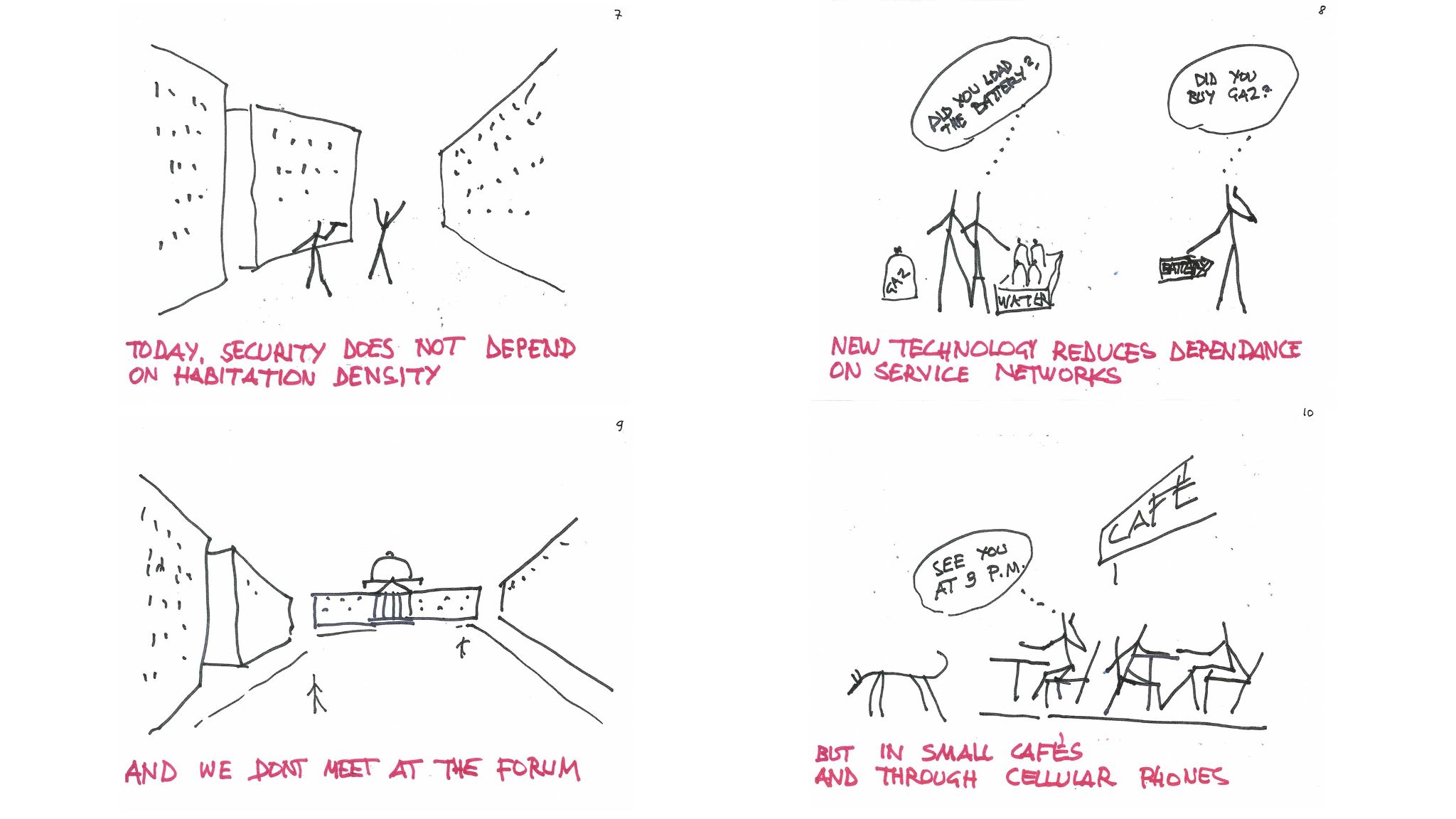
Yona Friedman
MOBILE ARCHITECTURE
Copy Pasta "During the 50’s a new architectural concept was developed by Yona Friedman in collaboration with the group GEAM “Groupe d’étude d’architecture mobile”. In 1958 the Hungarian-Israeli architect published a manifesto called Architecture Mobile that fostered a new type of free citizen able to conquer the space through huge ‘superstructures’ over the existing cities. Friedman envisioned that the increase of leisure time would profoundly change society, therefore cities should adapt to the new era.
This spatial approach wanted to promote the growth of cities without exhausting the use of land, for this, a spatial structure in terms of Yona Friedman, could superpose the pre-existing to achieve denser cities in which the citizen would have the freedom to expand it’s own home. The architect wanted to illustrate experts and non-specialists about architecture and urbanism so they could achieve an individual freedom."
" Critical for the Ville Spatial is what I call ‘spatial infrastructure’: a multi-storey space-frame-grid, which is supported by widely-spaced piles. […]
This infrastructure forms the fixed element of the city. The mobile element consists of walls, base-surfaces and dividing walls which make the individual division of the space possible; it could be called the ‘filling’ for the infrastructure.
All elements which come into direct contact with the users (i.e. those they see, touch etc.) are mobile, in contrast to the infrastructure, which is used collectively and remains fixed."
Copy Pasta "The citation relates accurately Yona Friedman’s intentions. Half a century later we can compare the theory with some built examples, observing different levels of success. Duplicating the “ground floor” and having an unlimited built area seems not to be always the solution to urban issues."
Urban Planning
Hannah Arendt
Voice
Rethinking the politics of voice (2009)
BY Nick Couldry
Copy Pasta "Listening matters for reasons other than the pleasures of aural attentiveness; of course, we have the faculty of hearing and listening, and exercising it gives most people great pleasure. But listening in the sense discussed here is not dependent literally on hearing; it could just as easily be practised by people deprived of hearing, whether using sign language or reading the words of others. Listening here is, first and foremost, the act of recognizing what others have to say, recognizing that they have something to say or, better, that they, like all human beings, have the capacity to give an account of their lives that is reflexive and continuous, an ongoing, embodied process of reflection. As the articles here bring out, the material conditions of listening are complex, and have been far too little explored. But rather than go over that important ground here, I want to take a step back and reflect on the normative framework that underlies it.
The reason we need to listen – and the reason why, arguably, depending on how we want to frame things, we have an ‘obligation’ to listen – is that all human beings have the capacity for voice, to give an account of their lives. This is an irreducible part of their human agency. If to acknowledge this is humanism, so be it; it should be obvious it need not rest on any simple notion of agency or on any complacent notion of the superiority of human life over other forms of life, let alone a privileged attempt to ‘speak for’ humanity from one site or another. This irreducible feature of human agency requires recognition, as a feature of every human agent, and therefore as a feature mutually shared by any two or more humans who interact with each other. (The concept of recognition I derive here from the work of the German social theorist Axel Honneth [Honneth 2007], but it could be articulated from other foundations too [see, for example, Ricoeur 2007], nor are Honneth's exact formulations essential to my comments here.) So, a mere claim by particular individuals or groups to ‘voice’, without any practice of listening, is contradictory, or at best incomplete.
Does this mean that the ‘politics of voice’ is itself contradictory? The answer is no, if by ‘voice’ we mean the implicitly linked practices of speaking and listening, based in a practice of mutual recognition, as understood in the essays here. But the answer is yes, if by the politics of voice we mean a claim to voice in isolation. So it is important to make clear that by ‘voice’ here we mean not the simple claim to speak (or the simple act of speaking in one's own name, important, of course, though that is). By ‘voice’ – necessarily – we mean something more: we mean the second-order value of voice that is embodied in the process of mutually recognizing our claims on each other as reflexive human agents, each with an account to give, an account of our lives that needs to be registered and heard, our stories endlessly entangled in each others' stories. As the late Paul Ricoeur put it: ‘in our experience the life history of each of us is caught up in the histories of others’ (1992, 161).
It is at this point that the mutual interweaving of the concepts of listening and voice becomes clear. For it is through the process of listening that the value of voice is mutually registered between us. The adjustments we make in order to listen better to others turn precisely on finding better ways of taking account of the complexities, the processual subtleties, of voice. So articulating the concept of listening, as the Listening Project does, plays a crucial role in filling out our understanding of the meaning of voice, both as a process in itself and as a second-order value.
But you might want to ask, why should any of this matter beyond perhaps a small conceptual clarification? It matters because, for nearly three decades and in many places, a very different politics has been dominant, a neoliberal discourse that reduces politics to market functioning and so, at a basic level, erases the value of ‘voice’, not just particular voices that might matter but the second-order principle that people's ability to give an account of their lives is an irreducible part of what must be taken into account in any form of social, political or economic organization. Neoliberal discourse has spread from economic thought to political doctrine, generating a ‘culture’ of neoliberalism so deeply engrained that it would be naive in the extreme to expect it simply to evaporate, just because a few slogans of market fundamentalism have become embarrassingly at odds with the widely known facts of how global markets operate. As an embedded culture, neoliberal discourse uses market language to normalize the absence of the value of voice. The result has been a crisis of voice (Couldry 2008; forthcoming) in economic, political and cultural domains."
" a neoliberal discourse that reduces politics to market functioning and so, at a basic level, erases the value of ‘voice’, not just particular voices that might matter but the second-order principle that people's ability to give an account of their lives is an irreducible part of what must be taken into account in any form of social, political or economic organization."
" The role of the aesthetic imagination as a political act was a key focus for the political theorist Hannah Arendt. While she rarely wrote about artworks her thinking sought to link the 'public sphere' as a 'space of appearances' to sense and the aesthetic imagination. How might we read Arendt's interest in judgment as a form of political thinking that draws on the work of art? Arendt identified a 'crisis of culture' as being intimately related to a 'crisis in thinking'"
Hannah Arendt on Architecture
"By ‘voice’ – necessarily – we mean something more: we mean the second-order value of voice that is embodied in the process of mutually recognizing our claims on each other as reflexive human agents, each with an account to give, an account of our lives that needs to be registered and heard, our stories endlessly entangled in each others’ stories."
Voice
Subversive communication against neoliberalism (2019)
Copy Pasta "The commons has experienced a revival in relation to the way
in which neoliberal logic has undermined living conditions, where basic commons – understood as resources needed for existence, such as water and soil (Mattei, 2014) – have been exploited and appropriated by market logics, and where people increasingly perceive their lack of decision-making power over collective life through institutional political processes. In this realm, the communicational aspect of the commons comes as a fundamental matter to inquire into the consequences that neoliberal logic has for the existence, extension, and preservation of voice – understood as the capacity and action to narrate, to be heard and to listen to others, making that communicative bond a constituent element in the construction of a common existence (Couldry, 2010; Freire, 1996; Saavedra Utman, 2019).
Architecture/ Model Making
"I argue that in a similar way to that which happens with water sources, forests, soil, education, and health systems, so neoliberalism expropriates voice as a commons.."
What does it mean when we say that voice has been expropriated as a commons? It
means that it is removed as a resource from the way democracies are run; as a relationship from the media landscapes; and ultimately as the entitlement for having voice, thus tackling the political aspect of our existence on its subjective, participatory, and conflictual dimension (Mouffe, 2005).
Ik denk dat we nu in Corona tijd toch ook weer worden geconfronteerd met de shortcomings of online communication. Was online communiceren ook niet vaak een tussenstap in het 'echt' communiceren? Hoeveel relaties vinden enkel en alleen plaats in the virtual realm?
Ik denk dat we nu in Corona tijd toch ook weer worden geconfronteerd met de shortcomings of online communication. Was online communiceren ook niet vaak een tussenstap in het 'echt' communiceren? Hoeveel relaties vinden enkel en alleen plaats in the virtual realm?
Verkenning van de Rechtvaardige Stad
By Simon Franke & Walter Veldhuis
City of Permanent Temporality
By ZUS
Copy Pasta "From a period of severe crisis and extreme megalomania, a unique piece of city has emerged in Rotterdam. Using unconventional strategies and radical forms of city making, ZUS has forged new links between architecture, economy, politics, and public space.
City of Permanent Temporality is a journal, project exhibit and a theory for a city that is in continuous transformation, where bricks & mortar and people continue to adapt, without ever being complete. The withdrawal of governments and turbulent market forces calls for new methods of planning and design.
City of Permanent Temporality sees ZUS, known for their award-winning Luchtsingel and the Schieblock, open the book on 18 years of urban activism. "
Copy Pasta "Franke en Veldhuis formuleren twee concrete cases waarin stedenbouwers nu al hun tanden zouden moeten zetten. De eerste ontlenen ze aan het onderzoek dat Mark Brearly deed naar de High Streets van Londen, die slechts 3,6 procent van de straten uitmaken, maar buiten het centrum wel meer dan de helft van de banen herbergen. Mooi zijn ze niet, wel uitermate vitaal. En juist aan zulke straten ontbreekt het in Nederland, mede door de preoccupatie van stedenbouw met schoonheid, representatie en identiteit. En dat leidt tot het tegenovergestelde van de High Streets, namelijk mooie straten die het ondernemerselan van buurtbewoners beknotten. In de termen van Richard Sennett: de cité (de geleefde stad) wordt ondergeschikt gemaakt aan de ville (de geplande stad). Sennetts pleidooi om het ontwerpen van identiteit dan maar helemaal bij het grof vuil te zetten, gaat Franke en Veldhuis te ver, maar ze vinden wel dat de reeds aanwezige kwaliteiten en identiteiten het uitgangspunt moeten zijn, en niet een of ander statisch eindbeeld. Kortom: minder vorm, meer flexibiliteit en programma
Het tweede speerpunt is het systeem van ‘residuele grondprijzen’, waarmee Nederlandse steden ontwikkelingen kunnen maken of breken. Te vaak is maximalisatie van de grondopbrengst het doel, waardoor niet-rendabele maatschappelijke en culturele voorzieningen moeten wijken voor zoveel mogelijk koopwoningen. Dat is echter geenszins een wet van Meden en Perzen: gemeentes kunnen, als ze dat willen, best een actieve grondpolitiek voeren. En ook stedenbouwers hebben speelruimte, bijvoorbeeld door slim overmaat in hun ontwerpen te smokkelen, waardoor de stad kan blijven ademen. Bijvoorbeeld door maatschappelijk voorzieningen op ruime kavels te plaatsen, of door bouwblokken zo diep te maken dat er later op de binnenterreinen nog kan worden verdicht."
Door slim overmaat in ontwerpen te smokkelen kunnen steden bouwkundigen grondpolitiek voeren, waardoor de stad kan blijven ademen, en de maximalisatie van de grondopbrengst kan worden geremd.
Opera/ Theatre
Economics
Forum
Bodys Isek Kingelez
CITY DREAMS (2013-2014)
“Without a model, you are nowhere. A nation that can’t make models is a nation that doesn’t understand things, a nation that doesn’t live,” said visionary artist Bodys Isek Kingelez (1948–2015).Kingelez’s “extreme maquettes” offer fantastic, utopian models for a more harmonious society of the future. An optimistic alternative to his own experience of urban life in his home city of Kinshasa, which grew exponentially and organically with urban planning and infrastructure often unable to keep step, his work explores urgent questions around urban growth, economic inequity, how communities and societies function, and the rehabilitative power of architecture—issues that resonate profoundly today.
" Rem Koolhaas zegt het in een interview in de Financial Times1 als volgt: ‘After Reagan and Thatcher and the fall of communism, neo-liberalism became the only thing. At that point, architects lost the connection to the public sector and they could no longer claim to serve the public good. We became extensions of individual ambitions. That lost us a lot of credibility.’"




Copy Pasta "Het is een van de verdiensten van de stadmakersbeweging dat we weer veel scherper zijn gaan denken over de verbinding tussen ruimtelijke en sociaal-culturele ontwikkeling, dat publieke waarden weer centraal staan. ‘Maar onze stadsontwikkeling is manisch-depressief en het is duidelijk dat we nu weer in een manische periode zitten, opgejaagd door de hoogconjunctuur’, vindt Endry van Velzen. Annius Hoornstra denkt dat we om de boel in de hand te houden en te sturen ‘behoefte hebben aan visie voor de grote schaal van de opgave’. Of moeten we dat juist niet hebben, omdat we veel beter kleinschalig in permanent overleg met bewoners en andere partijen gaandeweg kunnen ontwikkelen, wat heet, ‘knutselen’ noemt Frans Soeterbroek het. Hij is niet tegen visies, maar krijgt argwaan als die tot grote integrale plannen leiden. Onze gesprekspartners tijdens het schrijven van dit essay nemen alle posities in tussen beide uitersten of bepleiten beide tegelijkertijd."
"De aanbeveling vanuit de groep rond ‘foundational economics’ is: ‘innoveer sociaal’. We zien de private sector als vol van ondernemingslust, maar we moeten ook in de publieke sector ondernemingslust zien te ontwikkelen, niet om geld te verdienen, maar om uit te vinden hoe die fundamentele goederen en diensten beter zouden kunnen functioneren. Ga van daaruit zoeken naar andere organisatieen financieringsmodellen. Dan ontstaat een nieuwe positie ten opzichte van marktpartijen. Zoek daarin dus nieuwe samenwerkingsvormen waarin het publiek belang beter dan nu is gewaarborgd. Hoe we deze gedachtegang verankeren in de ruimtelijke inrichting van de stad, is een onderwerp voor het vervolg van ons project."
" we [kunnen] veel beter kleinschalig in permanent overleg met bewoners en andere partijen gaandeweg [...] ontwikkelen, wat heet, ‘knutselen’ noemt Frans Soeterbroek het."
"Without a model, you are nowhere. A nation that can't make models is a nation that doesn't understand things, a nation that doesn't live." Bodys Isek Kingelez (1948–2015)"
Claude Nicolas Ledoux
the Ideal City of Chaux
copy pasta "Convaincu que l’architecture peut permettre de bâtir un monde meilleur, Claude-Nicolas Ledoux rêve de prolonger le demi-cercle de la saline d’Arc et Senans en construisant une cité idéale en pleine campagne. Pour la ville de Chaux, qui n’a jamais été construite, Ledoux imagine de nombreux bâtiments, permettant aux habitants de s’instruire, se rencontrer ou se divertir."
copy pasta "L'architecture de Ledoux a toujours à voir avec le regard. Le demi-cercle de la saline permet une vision panoramique. Dans la ville de Chaux, on voit loin grâce aux avenues larges et rectilignes. Dans les bâtiments, les différents espaces sont séparés, mais le regard y circule.
Ces dispositions favorisent-elles une plus grande transparence ou facilitent-elles la surveillance ? Aujourd'hui encore, certains voient Ledoux comme un idéaliste, d'autres comme un précurseur des prisons où les détenus sont en permanence sous le regard des gardiens."
Via Michiel 9/11/20
Via Michiel 9/11/20
Katrin Sigurdardóttir
Ellefu (2015)
Via Michiel 9/11/20
copy pasta "In her work, Katrin Sigurdardóttir explores the way physical structures and boundaries define our perception. Through unexpected shifts in scale, she examines distance and memory and their embodiments in architecture, cartography and traditional landscape representations. While alluding to real locations, her works question the verity of these places, as well as our account of them. Sigurdardottir ́s work crosses the boundary between perceptual and embodied space, between vision and experience. She takes on the uneasy confrontation, when the viewer has to negotiate a new relationship with the miniature, see it as not representing other than itself, a disproportionate constructed object in the full-scale world."
copy pasta "Katrín Sigurdardóttir’s sculptural practice examines the way physical structures and boundaries affect perception. Her works gesture towards real locations, employing shifts in scale and fragmentation to systematically question the veracity of both memory and history. Sigurdardóttir’s exhibition at the MIT List Visual Arts Center will consist of two bodies of work recently completed as part of the commission for this project. The objects in the series Ellefu–Eleven in Icelandic–are abstracted, miniaturized constructions of interior segments of the artist’s childhood home in Reykjavík. For each of these floor-bound sculptures, the artist methodically regenerates cross-sections of rooms and passageways, their surfaces rendered without evidence of personal history. For the series Unbuilt Residences in Reykjavík, 1925-1930, Sigurdardóttir uses unrealized architectural drafts of houses to create models that are then destroyed by various means only to be reconstructed from the remains. The partially eroded structures evince a history simulated through a process as rehearsed and anticipated as it is left to chance."
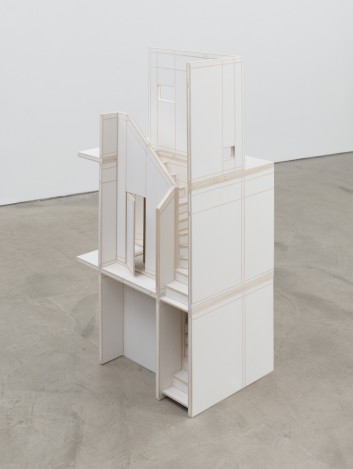
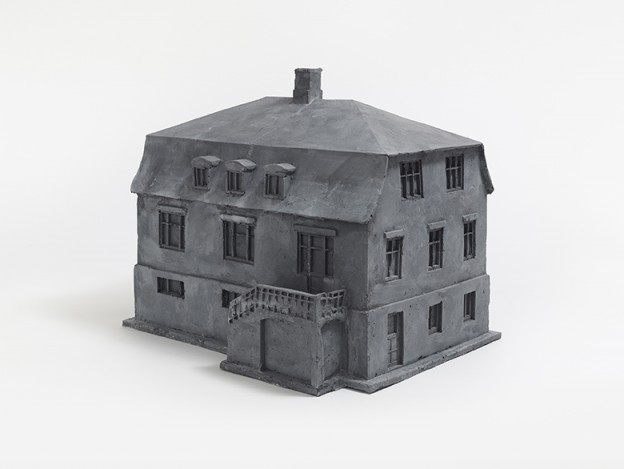
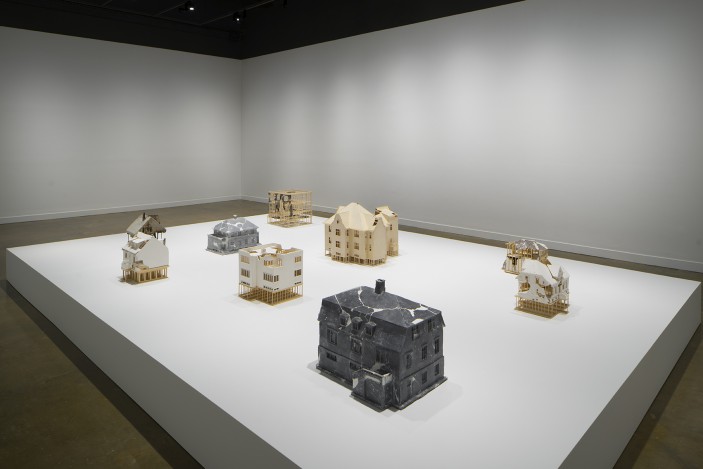
Isola (2015)
copy pasta "A miniature crooked wall/room, whose ground-plan is based on an island off the coast of Iceland. There are no doors or windows on the room, but there are elec- tric lights and air vents at regular interval."
Maya Deren
Voices of Haiti (1953)
Copy Pasta "Excerpted notes from the cover:
The belief that the proper performance of a sacred formula of symbols or sounds is the means by which man achieves contact with divine powers is a basic principle not only of Voudoun, but of every religion. Such formulae were known as mantras in ancient Sanskrit, and this is still the term for all such ritual action, whether the chants of the Muslim muezzin or the saying of the Catholic rosary. The use of mantras is as ancient and as universal as man's desire to improve his condition and secure his destiny. It is as prevailing as the proud conviction of each man that his weaknesses and inadequaceis are, by and large, common to all men and that, consequently, the power which is sufficiently superior to sustain and fortify him is one which is superior to man altogether. In times of need a man may seek to enlist such assistance by magic means. (...) If the songs and drumming achieve the compelling power which I believe is represented in this album it is because the microphone, lashed to the center post of the ceremonial peristyle, has captured a record not of men and women at play, not of their relaxed spontaneities, nor of their effort to create an art work for other men or for the satisfaction of any employer. It is a record of labor, of the most serious and vital effort which a Haitian makes, for he is here laboring for divine reward, addressing himself not to men but to divinity. They are singing for the gods. It is a privilege to have overheard and to have recorded it. -Maya Deren "
Side one
Creole O Voudoun (yanvalou) 5:02
Ayizan Marche (zepaules) 3:23
Signaleagwe Orroyo (yanvalou) 3:37
Zulie Banda (banda) 3:09
Ibo Lele (ibo) 1:16
Side Two
Ghede Nimbo (mahi) 4:39
Nogo Jaco Colocoto (nago crabino) 2:50
Miro Miba (congo) 2:59
Po' Drapeaux (petro mazonnei) 5:49"
Peter Cook
Archigram (founded 1960)
copy pasta "Peter Cook is regarded as one of the leading instigators of Archigram. This group whose name originated from the architectural pamphlet, Archigram – a wordplay on architecture and telegram- was founded in the 1960s by young British architecture graduates who strove to break away from traditional architectural office routine and continue the discourse stimulated during their studies. The given notions of form and space were to be overridden and burst apart, driven by the curiosity to explore what a future world may look like and question whether architectural language is at all set by boundaries.
Archigram searched for new solutions and concept models, focussing on the development of society. Underwater cities, living cells, plug-ins and hybrid villas were created: the ideas and experiments from this period, particularly the central motif of metamorphosis, recur throughout Peter Cook’s lifework."
copy pasta "In the series Way Out West: Berlin made in the 1980s, Peter Cook posed the question, “Why is the language of architecture so limited?”. A cactus is set with three symbols of Western architecture: the grid, a skyscraper and a square, where the spread of vegetation, again the process of metamorphosis, transforms the skyscraper to the point that it is no longer recognisable.
Some of his drawings are based on actual projects, such the urban planning development for Frankfurt-Oberrad in 1986, Real City: Frankfurt (which remained unrealised); many are rather experiments and utopias, such as Arcadia, Vegetated Lump and Hidden City, where the architecture was inspired by the surrounding vegetation, its beginning and end blurred, merging organically into nature."
Matt Mullican
copy pasta "Mullican is working on the development of a model for an imaginary world. A personal universe, with its own rules and laws. Through hypnosis he attempts to ‘evoke a conceivable, non-physical world as a counterpoint to the world as we experience it in everyday life’, writes Van Straaten.
This universe has taken the form of a ‘city of the mind’. In the exhibition, this ‘city’ is depicted in maps that are presented on large posters, drawings, in light boxes or in spatial forms. The highly personal and emotional early works, from which his later, much more rational and conceptual works derive, are also included in the exhibition."
City of the mind
Diller Scofidio + Renfro
Mile-Long Opera (1953)
Copy Paste "The Mile-Long Opera, a citywide public engagement project, brings together 1,000 singers from across New York for free performances on the High Line, October 3—8, 2018.
Co-created by architects Diller Scofidio + Renfro and Pulitzer Prize-winning composer David Lang, with words and lyrics by acclaimed poets Anne Carson and Claudia Rankine, The Mile-Long Opera: a biography of 7 o’clock is an ambitious, collective, free choral work that shares personal stories from hundreds of New Yorkers about life in our rapidly changing city."
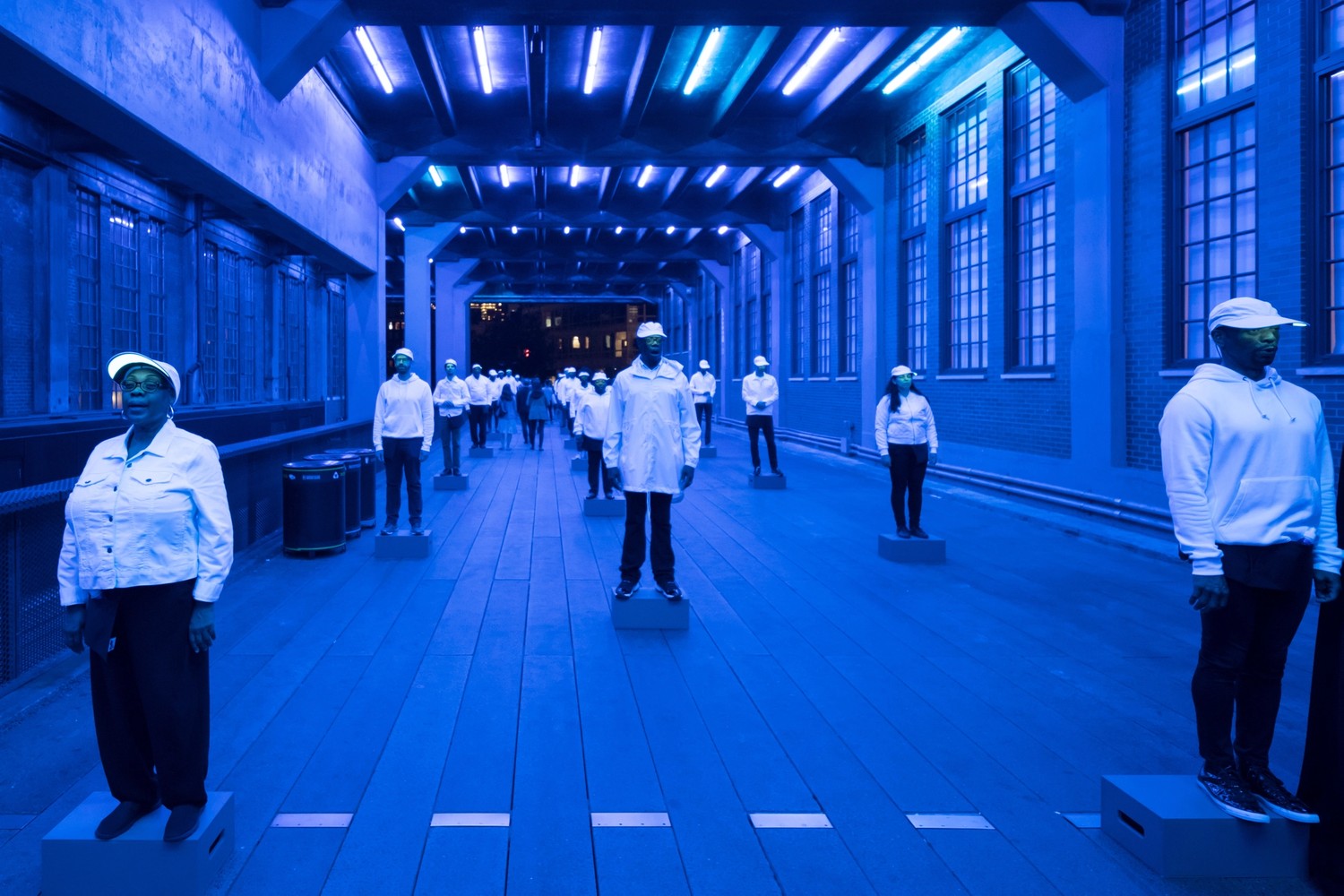
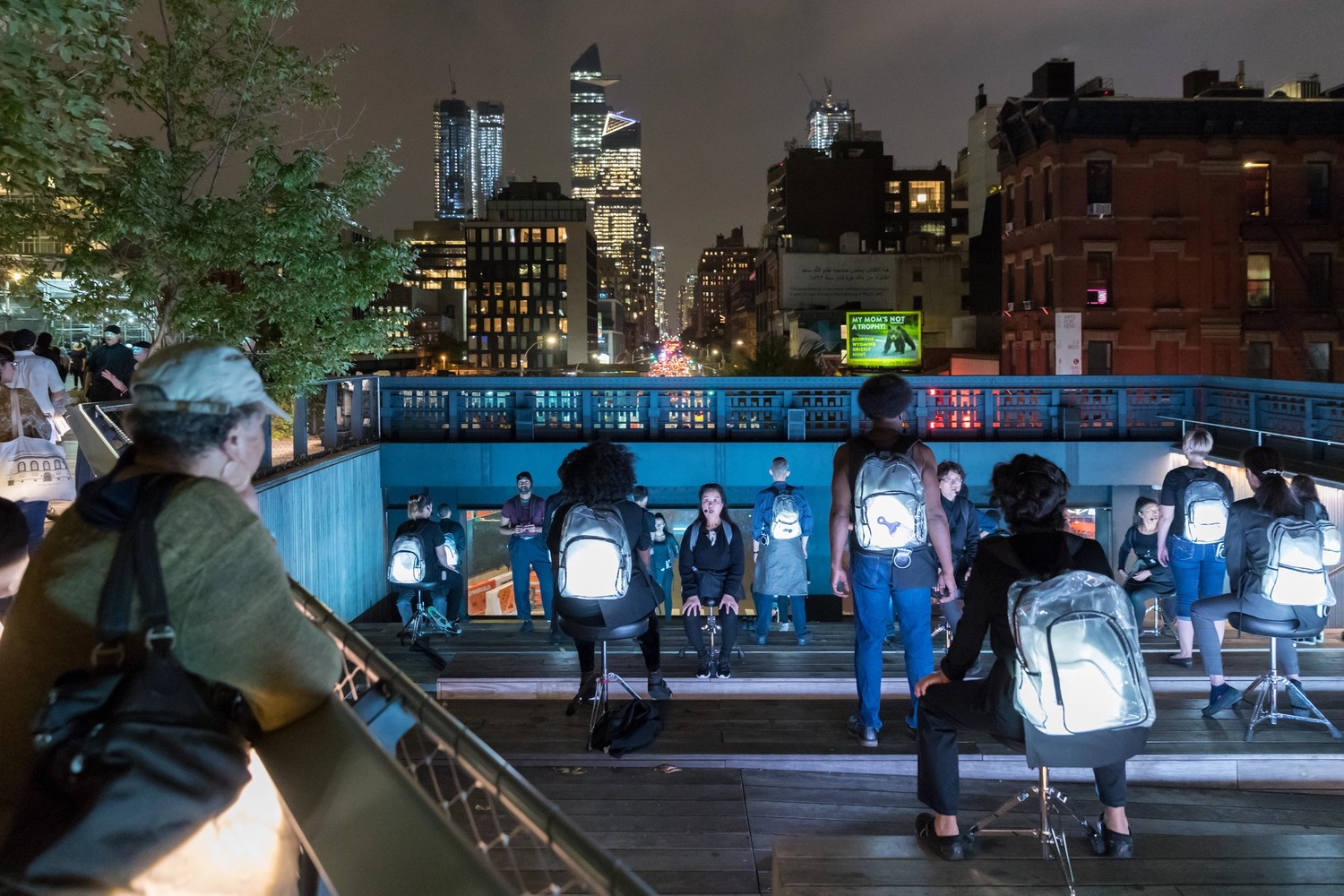
Copy Paste "The work focuses on the changing meaning of 7:00 pm, the time the performance begins each evening, and a time that represents a transition from day to night, when people shift from one activity to the next. It is also a time traditionally associated with family, stability and home, yet today, those associations are less predictable. The diverse stories told in The Mile-Long Opera are inspired by first-hand interviews with New Yorkers from all walks of life. Their individual experiences reflect unique ways of coping with the contemporary condition—anxiety, humor, nostalgia, vulnerability, joy, and outrage—that together form a biography of 7 o’clock."
The Forty Part Motet
The Forty Part Motet
Exhibiting sound as sculpture
Copy paste "The Canadian born Cardiff invites the audience to move through out the space and listen to each individual voice of the choir in the sound sculpture, an intimate experience, a new way of listening to a large choir of voices."
BY Jorge Saavedra Utman
Piplotti Rist
I'm a victim of this song
Via Olenka- video kunstenaar die ook met stem werkt- ongetrainde stem
" Commodification, which is part and parcel of growth, is eroding sociality and mores. Care, hospitality, love, public duty, nature conservation, spiritual contemplation; traditionally, these relations or ‘services’ did not obey a logic of personal profit (see anti-utilitarianism). Nowadays they increasingly become objects of market exchange, valued and paid for in the formal GDP economy. Profit motivations crowd out moral or altruistic behaviours and social wellbeing diminishes as a result (Hirsch 1976).'"
Introduction to Degrowth
Giorgos Kallis, Federico Demaria and Giacomo D’Alisa
Copy Paste "The fact that there are limits and growth is coming to an end is not necessarily bad. For many degrowthers, degrowth is not an adaptation to inevitable limits, but a desirable project to be pursued for its own sake in the search for autonomy. For Gorz (1982) autonomy is freedom from wagelabour.
Autonomous is the sphere of non-paid work where individuals and collectives
enjoy leisure and produce for their own use, instead of money. For Castoriadis
(1987) instead, autonomy means the ability of a collective to decide its future in
common, freed from external (‘heteronomous’) imperatives and givens, such as the
law of God (religion), or the laws of the economy (economics).
Complex systems call for specialized experts and bureaucracies
to manage them. They unavoidably lead to non-egalitarian and undemocratic
hierarchies. Autonomy instead requires convivial tools, i.e. tools which are
understandable, manageable and controllable by their users. An urban garden, a
bicycle or a Do-It-Yourself Adobe house are convivial and autonomous.
Degrowthers are critical of such high-tech projects of ecological modernization
and green growth not only because they might not turn out to be sustainable,
but because they reduce autonomy. Projects that signify a degrowth imaginary –
vacant lot gardening, pirate programming or bicycle repair shops – are convivial,
they involve voluntary work and they are governed and shaped directly by their
participants (see nowtopians)."
" vacant lot gardening, pirate programming or bicycle repair shops – are convivial, they involve voluntary work and they are governed and shaped directly by their participants (see nowtopians)."
Emma Goldman
Copy Paste "The Social Significance of the Modern Drama is a 1914 treatise by Emma Goldman on political implications of significant playwrights in the late nineteenth and early twentieth centuries."
The Social Significance of the Modern Drama (1914)
>>Er zijn ook twee theatre plays over haar geschreven
Copy Paste "The apolitical, technocratic discourse of sustainable development is a manifestation of a broader process of depoliticization of public debate in liberal democracies, whereby politics have been reduced to the search for technocratic solutions to pre-framed problems instead of a genuinely antagonistic struggle between alternative
visions.
Copy Paste "Growth all the way to the very limit of carrying capacity has an unrecognized political cost as well. Excess capacity is a necessary condition for freedom and democracy. Living very close to the carrying capacity limit, as on a submarine or
spaceship, requires very strict discipline. On submarines and spaceships we have
a captain with absolute authority, not a democracy. If we want democracy, we
should not grow up to the limit of carrying capacity – better to leave some slack
– some margin of tolerance for the errors that freedom entails."
Envisioning a Successful Steady-State
Economy
HERMAN DALY
" Excess capacity is a necessary condition for freedom and democracy."
Copy Paste "Economists assure us that [a world without boundaries] will lead to peace and prosperity among rational utility-maximizing individuals, minimally governed by a
benevolent World Democracy, dedicated to the post-modern values of secularist
materialism, eloquently communicated in Esperanto. This vision has its serious
appeal to many, but not so much to me. The anomaly of this cosmopolitan
globalism, is that it is really individualism writ large – corporate feudalism in a
global commons. Economic and political boundaries are necessary to achieve
both national community, and a global federation of national communities living
in peace and ecological sustainability."
Place, networks, space: theorising the
geographies of social movements
Copy Pasta "the territorial perspectives described above. For example, Amin and Thrift (2002, 72–3) argue that places within the city should not be viewed as bundles of thick and over-socialised relations that produce
distinctive political dispositions and strong-tie solidarities. Rather, these places are areas where actors with different statuses, geographical ties and mobilities interact in fleeting and unstructured ways. These interactions occur through a range of institutional arenas like public areas, schools,libraries, transportation, associations and government agencies (this is referred to as ‘light institutionalism’). Ideas and feelings are transmitted in contingent interactions. Some interactions may become more routinised than others, but rarely to the point of hardening into structured and strong-tie relations. These types of interactions play a crucial role in influencing the political identities and power relations of people. Anderson (2004), for example, shows that when diverse people interact in these settings, differences tend to be more openly negotiated and social boundaries eased.
Walter Nicholls
" People are repeatedly exposed to the unfamiliar and thus have the opportunity to stretch themselves mentally, emotionally, and socially . . . And often, though certainly not always, the end result is a growing social sophistication that allows diverse peoples to get along. (2004, 29)"
Copy Pasta "Others have pointed out that many of the institutions where interactions occur can also reinforce power relations (Bourdieu 1985). These institutions (i.e. schools, hospitals, markets, etc.) have their own distinct rules which reflect the power relations found in general society. When diverse people interact in these settings, the prevailing rules governing social interactions often reinforce hierarchies rather than break them down. Thus, places matter because they contain numerous institutions or sites where diverseinteractions occur. These contingent interactions help deconstruct and/or reinforce power relations in various ways."
" If space is really to be thought of relationally, and also
if Latour’s proposition is to be taken seriously, then
‘global space’ is no more than the sum of relations,
connections, embodiments and practices . . . Space is
not outside of place; it is not abstract, it is not somehow
‘up there’ or disembodied. (Massey 2004, 8)"
Copy Pasta "the view of place as bundled and territorialised relations has also reinforced the rather unhelpful place/space binary. Such a binary maintains that space refers to the abstract economic and political forces that unevenly structure the lives of people and place refers to the sites where people forge relations and negotiate with these abstract forces (this overlaps with the structure–agency binary, see Leitner and Miller 2007). This binary projects opposed and essentialist qualities on relations developing in space (fluid, general) and place (fixed, particular). In an effort to overcome this binary, Massey suggests that we begin to conceive of ‘space’ as the sum of concrete activities that occur in places, unevenly assembled through a series of relational networks. Space is not more than the sum of these activities; it does not bear any qualities that distinguish it from the individual places that constitute it (this might be considered to be geography’s version of ‘methodological individualism’)."
Copy Pasta "We should not reify space and see it as a ‘thing’ that is essentially different
from place. However, the radical reductionism advocated by Massey and others goes too far and blurs the distinctive properties of place and space. Space is made up of a variety of places but the mechanisms linking these places together produce a space with dynamics and properties that are qualitatively different from the properties of its constitutive places. Thus, the ‘relational’ view highlights various ways in which networks developing in places can play distinctive roles in social movements:
1- place creates opportunities for diverse actors with similar dispositions to establish contact with one another,
2- the interactions between diverse actors can help breakdown and/or reinforce power relations, and
3- activist nodes in places constitute and are constituted by their broader social movement space. Their particular activities feed into their broader social movement networks but their placement in this particular space also shapes the parameters of their own action."